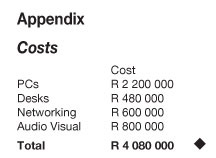Services on Demand
Article
Indicators
Related links
-
 Cited by Google
Cited by Google -
 Similars in Google
Similars in Google
Share
Journal of the Southern African Institute of Mining and Metallurgy
On-line version ISSN 2411-9717
Print version ISSN 2225-6253
J. S. Afr. Inst. Min. Metall. vol.112 n.7 Johannesburg Jul. 2012
JOURNAL PAPER
The establishment of a Mine Design Laboratory for improved teaching of and learning by Mining Engineering students: A case study
B. Genc; F. Cawood
School of Mining Engineering, University of the Witwatersrand, Johannesburg, South Africa
SYNOPSIS
Improving student success rates without compromising the quality of graduates is one of the biggest challenges expanding university programmes are facing in South Africa. By establishing a new Mine Design Laboratory (MDL) for higher learning in Mining Engineering, the School of Mining Engineering at the University of the Witwatersrand (Wits Mining) has achieved one of the important goals in its five-year strategic plan, i.e. to improve throughput in all years of study. Although the establishment of the laboratory has been a costly exercise, results so far have shown an improved success rate in most subjects taught in the facility. This paper outlines the design and equipment of the laboratory, the facilities incorporated, a comparison with the old laboratory, and the performance of studentsall of which indicate how important it is to have proper facilities to improve the teaching of, and learning by, large classes. Through this initiative, Wits Mining has taken an important step that will contribute to addressing the skills shortages in the mining industry.
Keywords: establishment of a Mine Design Laboratory for Mining Engineering students, Wits mining facilities, improving student success rate, addressing the skills shortages in the mining industy.
Introduction
South Africa is one of the wealthiest countries in the world in terms of mineral resources. It is the largest producer of platinum, and one of the leading producers of gold, diamonds, base metals, and coal. The South African mining industry's contribution towards the country's gross domestic product (GDP) varies between 5 to 10 per cent and it currently employs about 500 000 people (Department of Mineral Resources, 2010).
To capitalize on these valuable mineral resources, it is vital for the country to have available the necessary technical skills. This requires the availability of adequate numbers of mining engineers and corresponding skilled personnel. Such skilled staff, in turn, require the adequate education and training of personnel to meet the needs of the country. However, skilled personnel are currently in short supply. The worldwide shortage of mining engineers is well publicized. Phillips (2005) reported a growing disparity between supply and demand for mining engineers. Stacey et al. (2008) emphasized the strategic importance of addressing these skill shortages, since mining is a long-term business. The shortage of skills should be dealt with as a mining company strategy to ensure the supply of the necessary skills for future mining, since the lack of skills will have significant consequences for design, operations, productivity and safety of mines (Stacey et al., 2008).
The University of the Witwatersrand (generally known as Wits University) is one of the leading universities in South Africa. Wits enrolled 28 442 students in 2010 and its current undergraduate success rate is 78 per cent (University of the Witwatersrand, 2011a). Wits Mining is one of the Schools within the Faculty of Engineering and the Built Environment at Wits University. Wits Mining is the largest Mining Engineering school in the English-speaking world, and in February 2011 had 20 full-time academic staff members with 695 registered students (University of the Witwatersrand, 2011b). Table I shows staff-student numbers over the last three years and Table II shows the breakdown of student numbers from 1999 to 2011 for the different programmes. Therefore, Wits Mining is in a strong position to make a significant contribution to the provision of qualified mining engineers to the mining industry, and consequently, must ensure that its students are taught the appropriate subject matter at a consistently high level.

Mine design is a key aspect of mining engineering and includes all areas (technical, financial, environmental, health and safety, etc.) involved in the assessment of the profit potential of a mining venture from basic exploration data. The computer skills that are essential in mine design play a vital role in converting basic exploration data into a valuable mining asset. The teaching of modern mining engineering requires facilities to enable students to learn the necessary computer skills. For this reason, Wits Mining saw the need to establish a specialized Mine Design Laboratory (MDL) for the education and training of its mining engineering students. The MDL is a specialized computer laboratory that is specifically equipped with the relevant computer hardware and software for mine design and other mining-related work. The School had two main aims in establishing the MDL:
i. To provide a facility that would make mining-specific computer software available to mining engineering students
ii. To make available computers at the minimum ratio of one computer per two students, so that academic throughput and success rates of students could be improved.
Although student throughput has always been a problem for engineering disciplines, the change to the National Senior Certificate, which gives students access to university studies, has had a profound impact at first-year level. The impact of the conversion from the old matriculation certificate to an Outcomes-Based Education (OBE) certificate on Wits Mining is clearly visible in Table II. The first OBE class arrived at the university in 2009, and the statistics in Table II show:
A significantly higher number of first-year students as more students qualified for university admission
A very high attrition rate in first year, as only 85 of the 223 first-year students progressed to second year in 2010.
The number of first-year students reached 233 in 2011, the highest number in the School's history. As stated in its annual report (University of the Witwatersrand, 2010b), in line with a major goal in the strategic plan, the ratio of staff to students was reduced from one academic for every 43 students in 2010 to a ratio of one to 34 in 2011 . This change was achieved by limiting the number of postgraduate students. The School's ultimate objective is to reduce the present ratio of 34 students per lecturer to the point where it reflects the overall Wits University average of one staff member to about 25 students. The result was a significant reduction, in 2011, of the total number of enrolled students to 695 from 808 in 2010.
The School's four-year B.Sc. degree offers computer-related subjects from the start of the degree programme. First-year students are offered a simple introduction to computer skills. When they reach their fourth and final year, they are equipped to complete their Mine Design Project. Table III shows the number of computer-related courses that have been offered to the undergraduate students using the MDL. The MDL is also used for teaching several of the postgraduate courses that require computers.
In addition to the teaching of mining engineering students, Wits Mining provides service teaching to the School of Geosciences at Wits University. Some geology students attend second- and third-year computer subjects (mining) as well as some of the non-computer related mining subjects. Their numbers differ from year to year, varying between 10 and 37.
The old Mine Design Laboratory
The first MDL was established in the early 1990s with 10 PCs. In 1997, the MDL's capacity increased to 25 PCs, and 25 laptops were added in early 2008 to increase the ratio of available PCs per student. Therefore, in the old MDL in 2010, the School had a total of 50 workstations for 228 first-year students and 108 second-year students. The old MDL could accommodate up to 75 students (three students per desk). With a first-year class size in excess of 200 students, this lack of workstations was clearly an unacceptable situation and contributed to the student throughput problem. All of the 25 desks were identical; their dimensions being 180 x 90 x 70 cm as shown in Figure 1.

The old MDL had a floor area of about 200 m2. It had two large screens in the room to allow projection of the lecturer's PC screen. Wits Mining made use of the old MDL until the end of 2010. Table IV summarizes the computer-related subjects taught in the old MDL during 2009 and 2010.
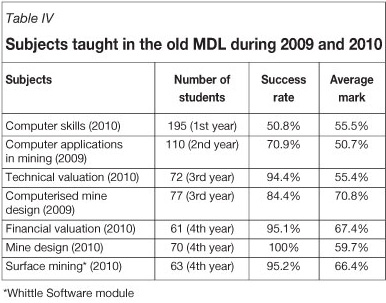
Over the past five years, Wits Mining's first-year intake increased well above the capacity of the School's computer facilities (refer to Table II). During 2010, the increased number of students forced Wits Mining to divide the first-and second-year computer courses into three and two classes respectively. The third-year computer course was also divided into two classes. The limited capacity with regard to computer facilities impacted on the performance of students. Table V shows the key statistics regarding the School's throughput of students in 2009 and 2010. The success rates for first- and second-year students were unacceptable and contributed significantly to the poor throughput rates.
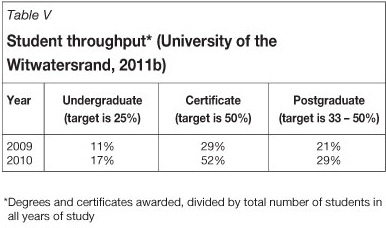
As an example, the ideal target throughput for the four-year undergraduate programme is 25 per cent. The 25 per cent target for the four-year undergraduate programme represents the situation where all entrants would graduate in four years. The throughput is calculated as the number of graduates in a year divided by the total headcount for that programme that year. Similarly, the ideal target for the two-year certificate programme is 50 per cent.
The School's aim has always been to assign an individual computer to each student to maximize the teaching and learning outcomes in order to achieve higher pass/throughput rates. With industry support, Wits Mining has established a new MDL for improved education and training of its mining engineering students.
The new Mine Design Laboratory
The fourth quadrant of the Chamber of Mines Building, where the Wits Mining is located on the West Campus of the University, was completed early in 2010. On the fourth floor of the new quadrant, just over 550 m2 area was allocated for a new MDL. This space represents more than a 100 per cent increase in area compared with the 200 m2 of the old MDL.
With this space allocation, Wits Mining aimed to establish a new MDL with the maximum number of PCs, bearing in mind the continually increasing number of students. Keeping the objective of assigning an individual computer to each student in mind, a new MDL with 99 PCs/desks was designed. One of the main reasons behind the establishment of a new MDL is the teaching of computer-related subjects to the mining engineering students. Wits Mining offers computer-related subjects during each year of study. Some courses are one block (about three months) long (e.g. MINN1001), some are a full-year course (MINN2000) and some are half-year courses as can be seen in Table II. From the third year onwards, the students are taught core mining software in preparation for their final-year subject and capstone courseMine Design.
The establishment of the new laboratory was a lengthy and complex task, since different suppliers were involved in completing the desired facility. Several months were spent researching the way forward to establish the laboratory. This entailed extensive investigations into the correct suppliers of furniture, audio-visual facilities, light fittings, and network switches.
The current features of the new MDL are:
100 networked PCs
99 PC desks to accommodate a maximum of 198 students (a maximum of two students per desk at first year level)
Specially designed computer desks
Fully integrated presentation capabilities
Full interaction between lecturer and students through an advanced sound system
Thirty-two invisible ceiling speakers
Four data projectors with motorized screens
A document camera, which eliminates the need for a white-board
Dimmable lights
Full control over students, monitors by the lecturer.
Although some lectures were presented in the new MDL from September 2010, it was officially opened only on 29 October 2010. The new MDL became fully operational only from the beginning of 2011 .
PCs
Every facet of the mining industry today makes use of some form of mining and commercial software. Kapageridis (2005) stated that the use of software is becoming more and more widespread, from exploration through mine design to rehabilitation. As Wits Mining's main objective is to prepare its graduates for the mining industry, teaching the use of mining software is a very important part of the curriculum. Wits Mining has strong ties with Gemcom Software (2010) and has historically made use of Gems, Whittle, and Surpac mine design and utilization software. Mining software packages usually require significant processing power, and the packages mentioned earlier are no exceptions. Even though Wits Mining offers different levels of computer-related courses, it was necessary to invest in a hardware configuration that would be sufficient for the seamless operation of the mining-related software, and also to complement the School's five-year strategic plan for the PCs to serve Wits Mining for at least five years. Table VI shows most of the available software in the MDL.
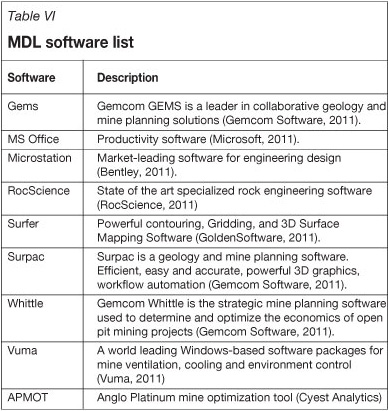
The MDL is now equipped with 100 Dell Precision workstations with Xeon processors, each running a 64-bit Windows 7 operating system, and each with 12 Gb of RAM and 22-inch LCD monitors. The pricing information is summarized in the Appendix .

PC desks
The final-year Mining Engineering students have to complete a Mine Design Project as their capstone course before graduating. During these projects, the students make use of large mine plans, which require a large working surface with minimum obstruction. In addition, Wits Mining wished to use this large new venue as an examination hall. These two requirements and the desire for the establishment of a multipurpose venue dictated that the computer monitors be placed under glass covers so that the PC desks could serve all purposes. Figure 3 shows the specially designed PC desk.

The new MDL has a floor area of about 550 m2. It has a reverse L-shape, as shown in Figure 5. Special PC desks were designed so that the available floor area could be fully utilized. Accordingly, all 99 desks are identical, with dimensions of 180 x 90 x 70 cm. Figure 4 shows the front section of the laboratory, and Figure 5 shows the distribution of the PCs in the facility.


Pricing information is included in the Appendix.
Networking equipment
The network speed plays an important role in terms of data transfer. Certain mine design software requires high-speed client-server connectivity. Wits Mining's network speed was upgraded to Gigabit (1000BaseT) speed in 2005. To achieve conformity with our new standard, Wits Mining decided to purchase three additional 96-port 1000BaseT pieces of networking equipment for the fourth quadrant of the building to serve not only the new MDL, but also the remaining PCs in the School.
Pricing information for the networking equipment is also shown in the Appendix.
Audio and visual equipment
Because of the size of the new MDL venue, with 100 PCs and up to 198 students, it was necessary to install a specialized sound system to ensure proper interaction between students and lecturer. This situation was unique, as the new MDL was not a conference venue where multiple speakers can interact. Wits Mining wanted to design the sound system so that only the lecturer's microphone is active at all times, and only one student microphone would be activated when the lecturer granted permission. Working closely with sound professionals, a special microphone system was designed. Microphones were attached to each PC desk. To prevent the unauthorized use of the system, a management control panel was designed, allowing control not only of the microphones, but also of 32 invisible ceiling speakers. Figure 6 shows a typical student microphone and the lecturer's control panel. Using the control panel, all the equipment in the venue can be managed. The following functions are available:

Control of the volumes of the lecturer's and the students' microphones
Management of the lights - on/off switch as well as dimming of the fluorescent lights
Control of four data projectors
Management of motorized screens
Control of student's screen by means of an on/off switch.
This control system makes both teaching and learning effective. Through the individually desk-mounted microphones and invisible ceiling speakers, not only can the lecturer be heard clearly by students, regardless of where they are sitting in the venue, but all students can also hear clearly when one student talks into his/her microphone. By referring to the four data projectors in the MDL, the students can easily see whatever the lecturer projects through his PC or the document camera. The document camera is capable of displaying whatever is put under the camera, which totally eliminates the need for a whiteboard. Through these innovations, students are not disadvantaged because of the location of the PC they are using, which was a significant problem in the old MDL.
New MDL and old MDLa comparison
The new MDL became partially operational in September 2010. The Computerised Mine Design (capstone) course was the first course taught in the new facility in 2010. Since then, all the School's computer-related courses have been scheduled to run in the new laboratory starting from 2011. Table VII compares the available features between the old and the new MDL. TableVIII shows the computer-related subjects taught in the new MDL during 2010 and 2011, indicating the numbers of students, course success rates, and the average mark for each course. Table IX compares the success rates between the old MDL and the new MDL, and Table X compares the average marks.

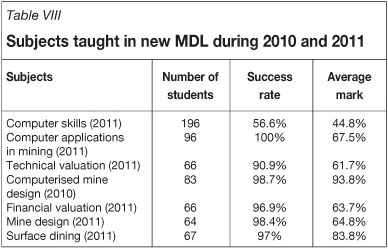
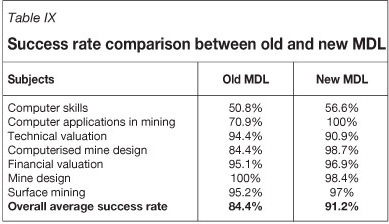
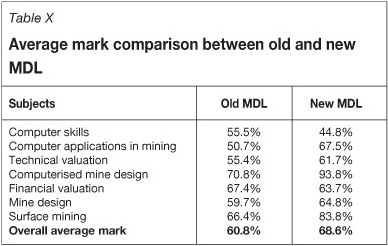
The data in Table IX demonstrates quite clearly the benefits that the new MDL has provided to the students and Wits Mining, as almost all the subjects taught have shown an improvement in the success rate. Although Table X indicates that in two subjects, course average marks fell, the overall average mark increased from 60.8 per cent to 68.6 per cent, in effect a 13 per cent increase. However, the very heartening result is that success rates have improved substantially, even over the short period that the new MDL has been in operation. This success is a clear demonstration that the throughput problems associated with teaching and learning in large classes can be partially addressed if students and lecturers have access to appropriate facilities.
Conclusion
The new MDL has already demonstrated its ability to improve teaching and learning with the much improved success rates in the new facility. Although the establishment was a costly project, the early results justify the investment in the facility. Through this initiative, Wits Mining has also taken an important step towards addressing the skills shortages in the mining industry. The aims of the School in establishing the new MDL has been achieved - an excellent and comprehensive mine design facility is now in operation; and improved throughput of students in computer-related subjects has already been demonstrated.
Acknowledgments
The School of Mining Engineering would like to acknowledge the following for their valuable contribution to the completion of the new MDL:
The Vice-Chancellor's infrastructure development programme
Anglo American for a donation to build the space for the MDL
Gold Fields for a donation to equip the MDL
Gemcom for a software donation
Vuma for a software donation
Burotab for a furniture discount
Wild and Marr for an audiovisual discount
Dell Computers for PC discount
Wits Campus Development and Planning for donating dimmable lights.
References
01. BENTLEY SOFTWARE. 2011. http://www.bentley.com/en-US/Products/microstation+product+line/ [Accessed 22 August 2011] [ Links ].
02. DEPARTMENT OF MINERAL RESOURCES. South African Minerals Industry (SAMI) Pretoria, 2010. [ Links ]
03. GEMCOM SOFTWARE. 2011. http://www.gemcomsoftware.com/products[Accessed 22 August 2011] [ Links ].
04. GOLDEN SOFTWARE. 2011 http://www.goldensoftware.com/products/surfer/surfer.shtml [Accessed 22 August 2011] [ Links ].
05. KAPAGERIDIS, I.K. 2005. The future of mine planning software - new tools and innovations. 19th International Mining Congress and Fair, June 9-12, Izmir, Turkey. [ Links ]
06. MICROSOFT OFFICE SOFTWARE. 2011. http://office.microsoft.com/en-za/ [Accessed 22 August 2011] [ Links ].
07. PHILLIPS, H.R. 2005. A long-term approach to the education of mining engineers. First International Seminar on Strategic vs. Tactical Approaches in Mining, Johannesburg, South Africa. [ Links ]
08. ROCSCIENCE SOFTWARE. 2011. http://www.rocscience.com/highlights/ [Accessed 22 August 2011].
09. STACEY, T.R., HADJIGEORGIOU, J., and POTVIN, Y. 2008. Technical skills - a major strategic issue. Journal of the Southern African Institute of Mining and Metallurgy, vol. 108, no. 8. pp. 775-782. [ Links ]
10. UNIVERSITY OF THE WITWATERSRAND. 2011a. Wits Facts. http://www.wits.ac.za/aboutwits/witstoday/facts-and-figures/3083/facts_and_figures.html [Accessed 21 August 2011] [ Links ].
11. UNIVERSITY OF THE WITWATERSRAND. 2011b. The School of Mining Engineering, Annual Report - 2011. http://www.wits.ac.za/academic/ebe/4810/-miningeng.html [Accessed 21 August 2011].
12. VUMA SOFTWARE. 2011. http://www.vuma.co.za/ [Accessed 22 August 2011].
Paper received Feb. 2012
Revised paper received Apr. 2012.
